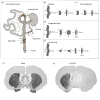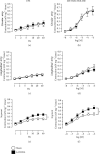6-OHDA-Induced Changes in Colonic Segment Contractility in the Rat Model of Parkinson's Disease
- PMID: 36743531
- PMCID: PMC9897937
- DOI: 10.1155/2023/9090524
6-OHDA-Induced Changes in Colonic Segment Contractility in the Rat Model of Parkinson's Disease
Abstract
Background: Gastrointestinal dysfunction is one of the most common non-motor symptoms in Parkinson's disease (PD). The exact mechanisms behind these symptoms are not clearly understood. Studies in the well-established 6-hydroxydopamine (6-OHDA) lesioned rats of PD have shown altered contractility in isolated circular and longitudinal smooth muscle strips of distal colon. Contractile changes in proximal colon and distal ileum are nevertheless poorly studied. Moreover, segments may serve as better tissue preparations to understand the interplay between circular and longitudinal smooth muscle. This study aimed to compare changes in contractility between isolated full-thickness distal colon muscle strips and segments, and extend the investigation to proximal colon and distal ileum in the 6-OHDA rat model.
Methods: Spontaneous contractions and contractions induced by electrical field stimulation (EFS) and by the non-selective muscarinic agonist methacholine were investigated in strip and/or segment preparations of smooth muscle tissue from distal and proximal colon and distal ileum in an in vitro organ bath comparing 6-OHDA-lesioned rats with Sham-operated animals. Key Results. Our data showed increased contractility evoked by EFS and methacholine in segments, but not in circular and longitudinal tissue strips of distal colon after central 6-OHDA-induced dopamine denervation. Changes in proximal colon segments were also displayed in high K+ Krebs-induced contractility and spontaneous contractions.
Conclusions: This study further confirms changes in smooth muscle contractility in distal colon and to some extent in proximal colon, but not in distal ileum in the 6-OHDA rat model of PD. However, the changes depended on tissue preparation.
Copyright © 2023 Maria Del Pilar Murillo et al.
Conflict of interest statement
The author(s) declare(s) that they have no conflicts of interest.
Figures






Similar articles
-
Local Change in Urinary Bladder Contractility Following CNS Dopamine Denervation in the 6-OHDA Rat Model of Parkinson's Disease.J Parkinsons Dis. 2015;5(2):301-11. doi: 10.3233/JPD-140509. J Parkinsons Dis. 2015. PMID: 25697958 Free PMC article.
-
Desipramine, commonly used as a noradrenergic neuroprotectant in 6-OHDA-lesions, leads to local functional changes in the urinary bladder and gastrointestinal tract in healthy rats.Heliyon. 2020 Nov 16;6(11):e05472. doi: 10.1016/j.heliyon.2020.e05472. eCollection 2020 Nov. Heliyon. 2020. PMID: 33251357 Free PMC article.
-
Role of nitric oxide in the impairment of circular muscle contractility of distended, uninflamed mid-colon in TNBS-induced acute distal colitis in rats.World J Gastroenterol. 2005 Sep 28;11(36):5677-84. doi: 10.3748/wjg.v11.i36.5677. World J Gastroenterol. 2005. PMID: 16237764 Free PMC article.
-
Intestinal dysmotility and enteric neurochemical changes in a Parkinson's disease rat model.Auton Neurosci. 2012 Aug 16;169(2):77-86. doi: 10.1016/j.autneu.2012.04.005. Epub 2012 May 16. Auton Neurosci. 2012. PMID: 22608184
-
Acute experimental distal colitis alters colonic transit in rats.J Surg Res. 1997 Apr;69(1):107-12. doi: 10.1006/jsre.1997.5042. J Surg Res. 1997. PMID: 9202655
Cited by
-
Effect of the Flavonoid Rutin on the Modulation of the Myenteric Plexuses in an Experimental Model of Parkinson's Disease.Int J Mol Sci. 2024 Jan 15;25(2):1037. doi: 10.3390/ijms25021037. Int J Mol Sci. 2024. PMID: 38256111 Free PMC article.
References
LinkOut - more resources
Full Text Sources

